
Old Kingdom Treasures
![]()
All artistic endeavors in the Old Kingdom were developed in connection with the Egyptian concept of kingship and religion. Art was thus a function of religion and the human body was celebrated as an image of the spirit within. Once a statue was animated by the ritual of 'Opening of the Mouth', it offered the possibility of housing the spirit which could then exist forever. The beauty that the Egyptian craftsman strove for was part of this function, to provide a handsome dwelling place for the spirit, and an attractive focus for veneration and offerings. |
![]()
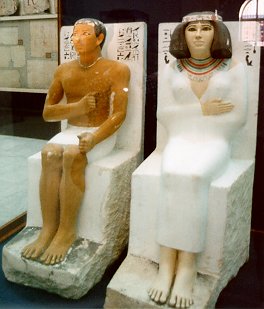 This
magnificent pair of painted limestone statues belonged to Prince Rahotep, a son of
Snofru, and Princess
Nofret, his wife. Found in a mastaba
tomb at Meidum, their wonderful state of preservation makes it hard to believe that these
statues are over 4,500 years old. In common with all Egyptian statues, the finished
stone was overlaid with a fine layer of plaster and painted. The skin tones for men
and women were completely different; women being depicted as paler through less exposure
to the sun. Nofret, unusually for a woman, wears a long cloak over her dress.
Her jewels are detailed in brightly colored paint. The inlaid eyes of both statues -
rock crystal with amethyst irises - give them an astonishing liveliness, especially when
illuminated in a beam of light. It is interesting to note that the majority of such
inlaid eyes show blue-gray, not brown, coloring. 4th Dynasty
This
magnificent pair of painted limestone statues belonged to Prince Rahotep, a son of
Snofru, and Princess
Nofret, his wife. Found in a mastaba
tomb at Meidum, their wonderful state of preservation makes it hard to believe that these
statues are over 4,500 years old. In common with all Egyptian statues, the finished
stone was overlaid with a fine layer of plaster and painted. The skin tones for men
and women were completely different; women being depicted as paler through less exposure
to the sun. Nofret, unusually for a woman, wears a long cloak over her dress.
Her jewels are detailed in brightly colored paint. The inlaid eyes of both statues -
rock crystal with amethyst irises - give them an astonishing liveliness, especially when
illuminated in a beam of light. It is interesting to note that the majority of such
inlaid eyes show blue-gray, not brown, coloring. 4th Dynasty 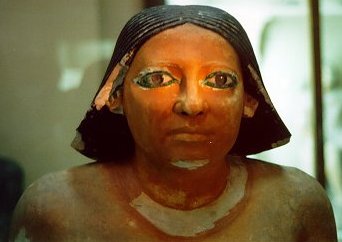 This
cross-legged statue with the amazingly lifelike eyes is one of a number of "seated
scribes," a theme upon which Egyptian sculptors lavished some of their greatest
talents. Of the many seated scribes, those of the Old Kingdom are the most remarkable.
Particularly notice the inlaid eyes, a feature that has elicited the admiration of
scholars, sculptors and, not least, physicians ever since the statues were discovered. The
practice of furnishing statues with inlaid eyes was continued at least into the New Kingdom, but the art was at its very height only during the
4th-Dynasty. Scholars studying the techniques
employed conclude that the Egyptians must have understood not only the anatomy of the eye
but also its refractive properties which they approximated by using combinations of stones
and crystals (up to four different kinds in a single eye). Early 5th Dynasty
This
cross-legged statue with the amazingly lifelike eyes is one of a number of "seated
scribes," a theme upon which Egyptian sculptors lavished some of their greatest
talents. Of the many seated scribes, those of the Old Kingdom are the most remarkable.
Particularly notice the inlaid eyes, a feature that has elicited the admiration of
scholars, sculptors and, not least, physicians ever since the statues were discovered. The
practice of furnishing statues with inlaid eyes was continued at least into the New Kingdom, but the art was at its very height only during the
4th-Dynasty. Scholars studying the techniques
employed conclude that the Egyptians must have understood not only the anatomy of the eye
but also its refractive properties which they approximated by using combinations of stones
and crystals (up to four different kinds in a single eye). Early 5th Dynasty
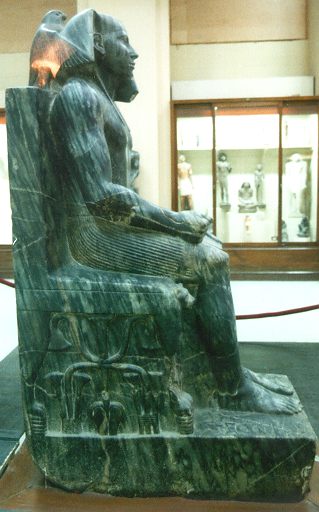 This majestic diorite-gneiss statue
depicts Khafre, fourth ruler of
the 4th-Dynasty and builder of the second
pyramid at Giza. The pharaoh is seated on a throne that rests on a
high base. The backrest reaches the pharaoh's shoulders above which is a falcon
protectively enfolding the pharaoh's head with its wings. The feet of the throne are
carved in the form of the paws of the lions whose heads decorate the front of the seat.
The side panels between the legs of the lions carry the characteristic sema-tawy
decorative motif in relief, the symbol of the 'union of the two lands'. The motif is
composed of the two heraldic plants of Lower and Upper Egypt, the papyrus and the lotus,
whose stems entwine around the hieroglyph for the windpipe and lungs, which can be read as
'unite'. Khafre wears the nemes headdress and a shendyt kilt.
The regal face is adorned with a false beard. This statue was found upside
down in a pit in Khafre's valley temple. The statue is generally acknowledged as one of
the great masterpieces of world sculpture. In terms of technique and expressiveness, this
would be a marvel of sculpture even if it were carved from marble or some other easily
managed stone, but it is carved from diorite, a granitic rock among the hardest known. 4th
Dynasty
This majestic diorite-gneiss statue
depicts Khafre, fourth ruler of
the 4th-Dynasty and builder of the second
pyramid at Giza. The pharaoh is seated on a throne that rests on a
high base. The backrest reaches the pharaoh's shoulders above which is a falcon
protectively enfolding the pharaoh's head with its wings. The feet of the throne are
carved in the form of the paws of the lions whose heads decorate the front of the seat.
The side panels between the legs of the lions carry the characteristic sema-tawy
decorative motif in relief, the symbol of the 'union of the two lands'. The motif is
composed of the two heraldic plants of Lower and Upper Egypt, the papyrus and the lotus,
whose stems entwine around the hieroglyph for the windpipe and lungs, which can be read as
'unite'. Khafre wears the nemes headdress and a shendyt kilt.
The regal face is adorned with a false beard. This statue was found upside
down in a pit in Khafre's valley temple. The statue is generally acknowledged as one of
the great masterpieces of world sculpture. In terms of technique and expressiveness, this
would be a marvel of sculpture even if it were carved from marble or some other easily
managed stone, but it is carved from diorite, a granitic rock among the hardest known. 4th
Dynasty
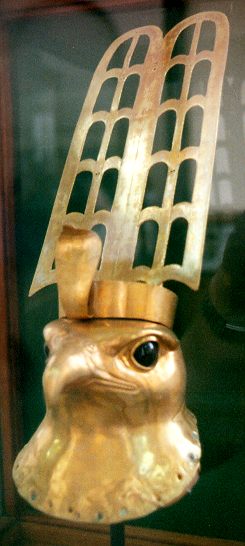 This superb gold hawk's head, representing the god Horus,
was found in the main deposit of Hierakonpolis. It was originally mounted on a
wooden body sheathed with plates of copper, but these were too badly damaged to
survive. Although numerous suggestions have been proposed regarding its date of
manufacture, there is as yet no attribution of the work to a specific period. The
problem lies in the extremely faithful reproduction of the characteristic features of the
bird, directly inspired by the tendency towards naturalism typical of Egyptian art of all
ages. Because it was found near two fine copper statues, one bearing the name of
Pepi I, it is generally believed to be of late
Old Kingdom date. The remarkable piercing eyes of the head are formed from a single
rod of obsidian which runs from side to side, each end being shaped and polished.
The twin-plumed headdress, decorated on the front with the royal uraeus,
was a later addition probably dating from the New Kingdom.
6th Dynasty
This superb gold hawk's head, representing the god Horus,
was found in the main deposit of Hierakonpolis. It was originally mounted on a
wooden body sheathed with plates of copper, but these were too badly damaged to
survive. Although numerous suggestions have been proposed regarding its date of
manufacture, there is as yet no attribution of the work to a specific period. The
problem lies in the extremely faithful reproduction of the characteristic features of the
bird, directly inspired by the tendency towards naturalism typical of Egyptian art of all
ages. Because it was found near two fine copper statues, one bearing the name of
Pepi I, it is generally believed to be of late
Old Kingdom date. The remarkable piercing eyes of the head are formed from a single
rod of obsidian which runs from side to side, each end being shaped and polished.
The twin-plumed headdress, decorated on the front with the royal uraeus,
was a later addition probably dating from the New Kingdom.
6th Dynasty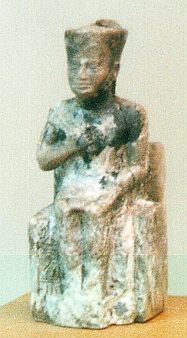 This miniature ivory figurine represents Khufu, the
builder of the Great Pyramid of Giza, seated on a low-backed
throne. The pharaoh's right hand is held to his chest and holds a flail while the
left hand rests on his left knee. He is wearing the Red Crown of Lower Egypt and a
short shendyt kilt. In spite of the the diminutive size of the piece, the
face is carved with great care, depicting in detail the narrow eyes, broad nose, a
rather large mouth and a projecting chin. It is ironic that this miniature statue, a
mere 7.5 cm tall, is the only surviving complete image of the builder on the greatest
pyramid in Egypt. 4th Dynasty
This miniature ivory figurine represents Khufu, the
builder of the Great Pyramid of Giza, seated on a low-backed
throne. The pharaoh's right hand is held to his chest and holds a flail while the
left hand rests on his left knee. He is wearing the Red Crown of Lower Egypt and a
short shendyt kilt. In spite of the the diminutive size of the piece, the
face is carved with great care, depicting in detail the narrow eyes, broad nose, a
rather large mouth and a projecting chin. It is ironic that this miniature statue, a
mere 7.5 cm tall, is the only surviving complete image of the builder on the greatest
pyramid in Egypt. 4th Dynasty© All pictures are Copyright 1998 - 2001 Grisel Gonzalez